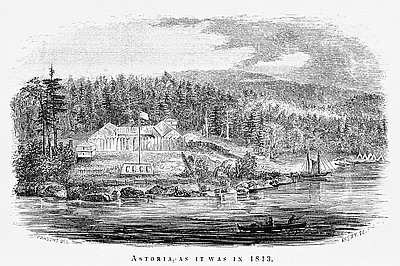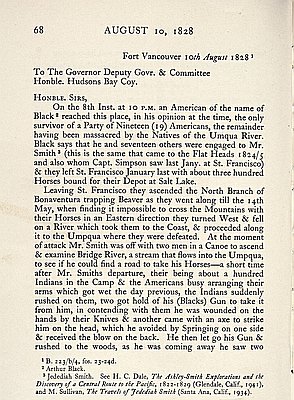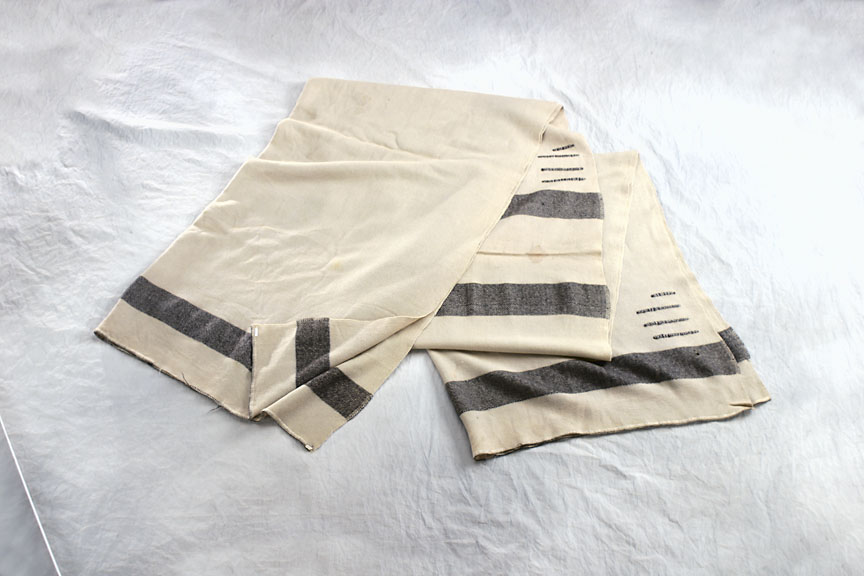- Catalog No. —
- OHS Museum 78-50.1
- Date —
- n.d.
- Era —
- 1792-1845 (Early Exploration, Fur Trade, Missionaries, and Settlement)
- Themes —
- Environment and Natural Resources, Native Americans, Trade, Business, Industry, and the Economy
- Credits —
- Oregon Historical Society
- Regions —
- Oregon Country
- Author —
- Hudson's Bay Company, London
Hudson's Bay Company Blanket
White blankets like this Hudson’s Bay Company (HBC) blanket were among the first to be traded among fur trappers and Native Americans in North America. They were especially popular with hunters in the northernmost regions of the continent because they provided both warmth and camouflage during winter.
Formed in 1670 by the granting of a royal charter, the London-based Hudson’s Bay Company established its original fur-trading empire in the watershed of Hudson’s Bay in northeastern North America. By the 1820s, the HBC had expanded its territory across the continent to the Pacific Ocean. All the while, the company profited from its trading relationships with Native American groups. The company’s North American administrators—mostly college-educated Scotsmen—kept the London office apprised of the trade goods in demand by their Indian trading partners. In turn, the London office attempted to keep their trading posts across North America stocked with goods that would be valued enough within Indian communities to entice them to hunt and trap furs valued in European markets.
Blankets were one of the HBC’s most highly sought after goods. Faced with the challenge of convincing Indians along the lower Columbia River that it was more desirable to trap beaver than to fish for salmon, the Chief Factor of Fort Vancouver, Dr. John McLoughlin, briefly prohibited his employees from trading the blankets for fish. Indians who wanted the blankets were subsequently required to obtain their blankets by providing furs. Only after McLoughlin had developed a market for salted salmon in the Sandwich Islands—now referred to as the Hawaiian Islands—did he again allow blankets to be traded for the locally-abundant fish.
For a time, the HBC tried to fix prices by sewing stripes, called points, onto the edges of their blankets. Blankets were marked for sale with up to four points, each point representing a “made beaver,” which was the accepted standard prime quality, adult size beaver pelt. However, Native Americans across North America were quick to balk at the dictated prices since the pricing strategy didn’t allow for any haggling. To Native American traders, prices were always negotiable. Eventually the points were used instead as a mark of size, a practice which has continued to this day.
Further Reading:
Mackie, Richard. Trading Beyond the Mountains: The British Fur Trade on the Pacific, 1793 – 1843. Vancouver, B. C., 1997.
Vaughan, Thomas and Bill Holm. Soft Gold: The Fur Trade and Cultural Exchange on the Northwest Coast of America. Portland, Oreg., 1982.
Written by Joshus Binus, © Oregon Historical Society, 2004.
Related Historical Records
-
The Astorians and the Hudson’s Bay Company
The Astorians were the first fur traders to arrive. New York entrepreneur John Jacob Astor sent two groups of clerks to the Columbia River country—one by sea and …

-
John McLoughlin to Hudson's Bay Co., 1828
John McLoughlin, chief factor of the Hudson’s Bay Company’s Columbia Department, wrote this letter to his superiors on August 10, 1828—two days after Arthur Black, one of four survivors of …

